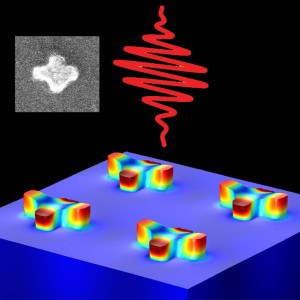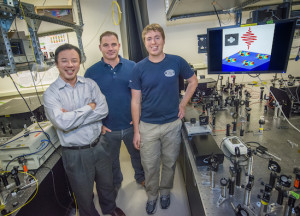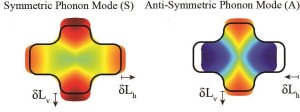
Gold plasmonic nanostructures shaped like Swiss-crosses can convert laser light into ultrahigh frequency (10GHz) sound waves.
An advance has been achieved towards next generation ultrasonic imaging with potentially 1,000 times higher resolution than today’s medical ultrasounds. Researchers with the U.S. Department of Energy (DOE)’s Lawrence Berkeley National Laboratory (Berkeley Lab) have demonstrated a technique for producing, detecting and controlling ultrahigh frequency sound waves at the nanometer scale.
Through a combination of subpicosecond laser pulses and unique nanostructures, a team led by Xiang Zhang, a faculty scientist with Berkeley Lab’s Materials Sciences Division, produced acoustic phonons – quasi-particles of vibrational energy that move through an atomic lattice as sound waves – at a frequency of 10 gigahertz (10 billion cycles per second). By comparison, medical ultrasounds today typically reach a frequency of only about 20 megahertz (20 million cycles per second.) The 10GHz phonons not only promise unprecedented resolution for acoustic imaging, they also can be used to “see” subsurface structures in nanoscale systems that optical and electron microscopes cannot.
“We have demonstrated optical coherent manipulation and detection of the acoustic phonons in nanostructures that offer new possibilities in the development of coherent phonon sources and nano-phononic devices for chemical sensing, thermal energy management and communications,” says Zhang, who also holds the Ernest S. Kuh Endowed Chair Professor at the University of California (UC) Berkeley. In addition, he directs the National Science Foundation’s Nano-scale Science and Engineering Center, and is a member of the Kavli Energy NanoSciences Institute at Berkeley.
Zhang is the corresponding author of a paper describing this research in Nature Communications. The paper is titled “Ultrafast Acousto-plasmonic Control and Sensing in Complex Nanostructures.” The lead authors are Kevin O’Brien and Norberto Daniel Lanzillotti-Kimura, members of Zhang’s research group. Other co-authors are Junsuk Rho, Haim Suchowski and Xiaobo Yin.
Acoustic imaging offers certain advantages over optical imaging. The ability of sound waves to safely pass through biological tissue has made sonograms a popular medical diagnostic tool. Sound waves have also become a valuable tool for the non-destructive testing of materials. In recent years, ultrahigh frequency sound waves have been the subject of intense scientific study. Phonons at GHz frequencies can pass through materials that are opaque to photons, the particles that carry light. Ultrahigh frequency phonons also travel at the small wavelengths that yield a sharper resolution in ultrasound imaging.

Xiang Zhang, Haim Suchowski and Kevin O’Brien were part of the team that produced, detected and controlled ultrahigh frequency sound waves at the nanometer scale. (Photo by Roy Kaltschmidt)
The biggest challenge has been to find effective ways of generating, detecting and controlling ultrahigh frequency sound waves. Zhang, O’Brien, Lanzillotti-Kimura and their colleagues were able to meet this challenge through the design of nanostructures that support multiple modes of both phonons and plasmons. A plasmon is a wave that rolls through the conduction electrons on the surface of a metal.
“Through the interplay between phonons and localized surface plasmons, we can detect the spatial properties of complex phonon modes below the optical wavelength,” O’Brien says. “This allows us to detect complex nanomechanical dynamics using polarization-resolved transient absorption spectroscopy.”
Plasmons can be used to confine light in subwavelength dimensions and are considered to be good candidates for manipulating nanoscale mechanical motion because of their large absorption cross-sections, subwavelength field localization, and high sensitivity to geometry and refractive index changes.
“To generate 10 GHz acoustic frequencies in our plasmonic nanostructures we use a technique known as picosecond ultrasonics,” O’Brien says. “Sub-picosecond pulses of laser light excite plasmons which dissipate their energy as heat. The nanostructure rapidly expands and generates coherent acoustic phonons. This process transduces photons from the laser into coherent phonons.”
To detect these coherent phonons, a second laser pulse is used to excite probe surface plasmons. As these plasmons move across the surface of the nanostructure, their resonance frequency shifts as the nanostructure geometry becomes distorted by the phonons. This enables the researchers to optically detect mechanical motion on the nanoscale.
“We’re able to sense ultrafast motion along the different axes of our nanostructures simply by rotating the polarization of the probe pulse,” says Lanzillotti-Kimura. “Since we’ve shown that the polarization of the pump pulse doesn’t make a difference in our nanostructures due to hot electron diffusion, we can tailor the phonon modes which are excited by designing the symmetry of the nanostructure.”

When the two arms of this Swiss-cross nanostructure oscillate in phase, symmetric phonons are produced. When the arms oscillate out of phase, anti-symmetric phonons are generated. The differences enable the detection of nanoscale motion.
The plasmonic nanostructures that Zhang, O’Brien, Lanzillotti-Kimura and their colleagues designed are made of gold and shaped like a Swiss-cross. Each cross is 35 nanometers thick with horizontal and vertical arm lengths of 120 and 90 nanometers, respectively. When the two arms oscillate in phase, the crosses generate symmetric phonons. When the arms oscillate out of phase, anti-symmetric phonons are generated.
“The phase differences in the phonon modes produce an interference effect that allow us to distinguish between symmetric and anti-symmetric phonon modes using localized surface plasmons,” O’Brien says. “Being able to generate and detect phonon modes with different symmetries or spatial distributions in a structure improves our ability to detect nanoscale motion and is a step towards some potential applications of ultrahigh frequency acoustic phonons.”
By allowing researchers to selectively excite and detect GHz mechanical motion, the Swiss-cross design of the plasmonic nanostructures provides the control and sensing capabilities needed for ultrahigh frequency acoustic imaging. For the material sciences, the acoustic vibrations can be used as nanoscale “hammers” to impose physical strains along different axes at ultrahigh frequencies. This strain can then be detected by observing the plasmonic response. Zhang and his research group are planning to use these nanoscale hammers to generate and detect ultrafast vibrations in other systems such as two-dimensional materials.
This research was supported by the DOE Office of Science through the Energy Frontier Research Center program.
Additional Information
For more about the research of Xiang Zhang go here
Xiang Zhang can be reached for comment at: 510-643-4578.
###
Lawrence Berkeley National Laboratory addresses the world’s most urgent scientific challenges by advancing sustainable energy, protecting human health, creating new materials, and revealing the origin and fate of the universe. Founded in 1931, Berkeley Lab’s scientific expertise has been recognized with 13 Nobel prizes. The University of California manages Berkeley Lab for the U.S. Department of Energy’s Office of Science. For more, visit www.lbl.gov.
The DOE Office of Science is the single largest supporter of basic research in the physical sciences in the United States and is working to address some of the most pressing challenges of our time. For more information, please visit science.energy.gov.
